On board Celeste, some place north-east of Scotland, south-east of Orkney, 21 August 2014.
The prognosis was for very little wind until we passed Lindesnes and then quite a lot of it because of a low pressure area over Skagerrak. We had passed one front on our way up from Gothenburg, but to reach the Orkneys we had to pass through the other side (Ill. 1 – amateurishly done by me).

We were expected to hit the rough weather around midnight and that it would last for approximately 24 hours, with more wind and significantly taller waves than we’d had in Kattegat. But towards the end of our watch from 3 to 6 pm (Tuesday the 19th) the wind picked up and the waves turned choppy. Shortly after (I was just headed for bed, since we were going on watch again at midnight) Karin went round checking with each of us that we were ok with continuing – the forecast at this point was “rough for 48 hours”.
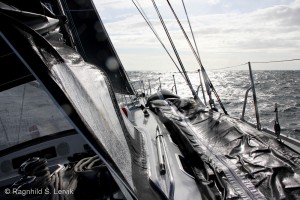
I said ok, as long as I don’t have to take the helm (I’d been at the helm earlier, while it was calm, but did not particularly want that responsibility in rougher conditions). A part of me wanted to say “I want my mummy, let me off at the nearest islet!”, but I’d signed up to sail, after all, and I assumed that the crew knew what they were about and what Celeste was capable of and weren’t about to risk the boat or their own lives. I suspect a couple of my shipmates also had an internal discussion, but everyone said to og ahead, so we continued on our course straight into the storm. I didn’t really sleep, what with the commotion and all, and when I clambered up on deck at midnight, both Bengt, Jens and Karin were there, taking turns at the helm. The rest of us wedged ourselves in the most comfortable positions we could. I think I must have nodded off now and again, for suddenly the watch was over and I could creep back to the bunk. Perhaps I should have stayed on deck, because now I found sleep escaped me, my back and hips were far from happy (the bunks were rather hard) and Celeste would crest the choppy waves and then land in the trough with a bang, with everything, including us, being thrown foreward.
Above deck there was action enough. At some point it was discovered that the IPIRB which was supposed to hang aft ready for use was missing. IPIRB stands for Individual Position Indicating Rescue Beacon and is activated when thrown (or lost) into the sea. The point is that it sends a distress signal if the boat is actually in trouble, but at the receiving end it’s obviously impossible to tell an accidentally lost IPIRB from a real distress signal. Attempts had been made to reach us via radio, but there had not been any response (since everyone who had any knowledge of the radio were busy on deck). I overheard Karin’s somewhat frantic call to someone on land that, no, we were fine, the boat was fine, we had just lost the transmitter. At that point a rescue operation was already in progress, a boat had left shore and a helicopter had been requested. To everyone’s relief, no doubt, the rescue operation could be called off and we continued our sailing into the wind, which showed no sign of lessening.
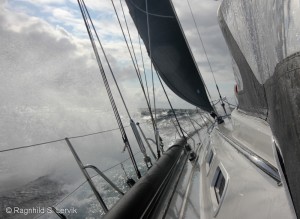
After our nine-to-twelve-watch on Wednesday the only real options were to stay on deck or lie on a bunk, so I did a bit of both. Celeste was leaning and bucking about too much for anything else.
By the time we came on watch again at six the wind had dropped and the waves, though still rather tall, were less choppy.
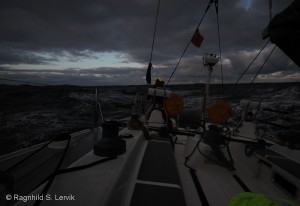
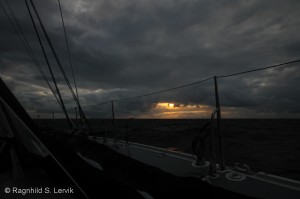
Our night watch, 3 to 6 am Thursday morning, was quite calm. The wind was still from the west, giving us a speed of between 5 to 7 knots and variously cloudy and clear, so we could se the stars (there are a lot of them when you’re in the middle of the sea, with little to no light pollution around). The waves that regularly submerged the rails were teeming with phosphorescence. Karin was at the helm for most of the watch, but asked if I could take over so she could have a break, and in these conditions I was fine with it, so I spelled her for a while.
Just before we went off watch we took the reef out of the mainsail with the help of Bengt’s watch who were on after us.
I went to bed and actually slept this time, from six to about eleven, and when I got up we had gone about and also started the engine again, because even with the reef out of the mainsail we were only doing 2 to 4 knots, and we’ve got a date in Kirkwall on Friday.
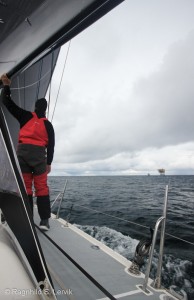
All of Thursday passed on a steady course towards Kirkwall with the engine going off and on depending on the strength of the wind. At some point we tried setting the gennaker (similar to a spinnaker, but uses the same mast as the jib), but by the time it was up the wind had dropped, so there was nothing to do but take it down again.

It’s now just gone half past six in the evening, and about an hour ago we hauled down the mainsail as it was not being filled (and then it slows the boat) and we’re running on engine at about 6 knots. I’m on watch again at nine and I don’t think I can be bothered to try to sleep before that. We’re heading for a calm night, but expecting more wind in the morning. It would be nice to arrive in Kirkwall with the sails up, bare masts look rather sad.
There is no chance of making landfall Thursday at this point, but we’re hoping to make the planned tour of Highland Park at two pm Friday. It helps that that is GMT while we’re still on CET, but it might still be a close call.
I can’t even begin to describe how nice it will be to sleep in a bed that is stationary and horisontal again.
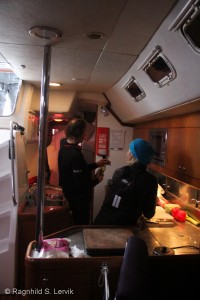

2 thoughts on “The Dark Expedition – Part 2”